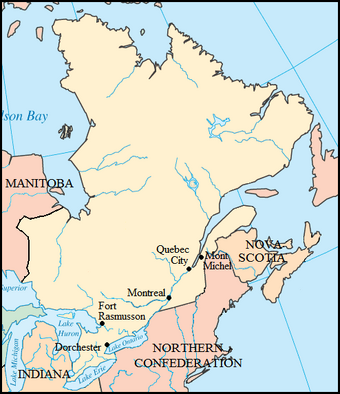
Confederation of Quebec, 1782-1889.
The Confederation of Quebec was one of the five original confederations that made up the Confederation of North America under the Britannic Design. Its capital is Quebec City, and its largest city is Montreal. Other notable cities include Dorchester, Fort Rasmusson, and Mont Michel. The chief executive is the Governor of Quebec and the legislature is the Quebec Council.
Conquest by Great Britain[]
Quebec, also known as Canada, was originally a French colony that was conquered by the British between 1758 and 1761 during the French and Indian War. During the negotiations for the Treaty of Paris in 1763, the British returned most of the conquests they had made in the war, but retained control of Quebec. The British also agreed in the treaty to permit Quebec's inhabitants to practice the Catholic religion, which was viewed with suspicion by the inhabitants of the older British colonies. Francophones continued to make up a majority of Quebec's population, and they were never entirely reconciled to being part of a majority-English country.
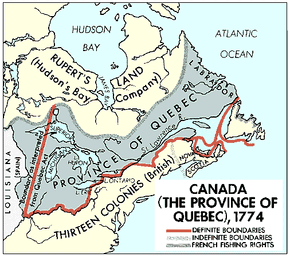
Under the Quebec Act of 1774, the British Parliament expanded Quebec to include the area between the Great Lakes and the Ohio River, which several of the older colonies had claims on. This exacerbated the American Crisis, and led to the outbreak of the North American Rebellion the following year.
The Britannic Design[]
After the Rebellion was suppressed in 1778, General Sir Guy Carleton, the Governor of Quebec, was invited to London to help Parliament draft the Britannic Design, a new instrument of government for the American colonies. Carleton, along with William Smith and Francis Legge, urged that Quebec be incorporated into the Design to provide a counterbalance to the colonies that had participated in the Rebellion. To ensure a preponderance of Loyalist confederations in the Design, Quebec was divided into three sections, with the area south of the Great Lakes becoming the Confederation of Indiana, and the largely unpopulated area north and west of Lake Superior becoming the Confederation of Manitoba. Although Sobel never specifically says so, the Hudson's Bay Company's territory of Rupert's Land was apparently also brought under the Design at this time, and divided between Quebec and Manitoba.
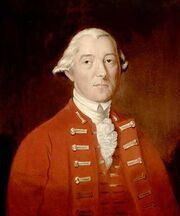
General Sir Guy Carleton.
After passage of the Design in January 1781, Carleton, who had been raised to the Peerage as Lord Dorchester, was appointed the new Governor-General of the Confederation of Quebec on 2 July 1782. Dorchester was suspicious of the inhabitants of the rebellious colonies, regarding them as being of dubious loyalty, and it was only the diplomatic skill of Sir John Dickinson of Delaware, the newly-appointed Viceroy of the Confederation of North America, that allowed amicable relations to continue between Quebec and the new Northern Confederation. A threatened war between Quebec and the N.C. in 1788 over a border dispute was averted by Dorchester and Governor-General George Clinton.
There was little enthusiasm among the inhabitants of Quebec when news reached the confederation of the outbreak of the Trans-Oceanic War with France. During the war, Paul Cerdan sought to rally the Francophone population to support the French, but was unsuccessful. After the British victory in the war, the growth of commerce and industry in the N.C. resulted in Quebec becoming an economic adjunct to it. This led to the rise of a separatist movement among the Francophone population that was organized into the Free Quebec Party in 1810 by Cerdan and Pierre Ribot. The F.Q.P sought recognition of French Quebec's autonomy within the confederation. Although Ribot professed loyalty to the C.N.A., it was later learned that he sought the violent overthrow of the Anglophone government in Quebec City and independence for Quebec. However, Cerdan and Ribot were dull men who lacked the charisma needed to lead a popular movement.
Two other political parties appeared among the confederation's Anglophone population. The wealthier citizens of Quebec City formed the Liberal Party, also known as the Progress Party, which sought investment from New York City and London to increase commerce and industry, and develop the north country. The Liberal Party called for strong imperial ties and full partnership in the C.N.A. In response, a group of farmers, urban workers, and small business owners centered in Montreal formed the Farmers Congress in 1812, which was renamed the Conservative Party the following year. The Conservatives opposed industrialization, and sought to keep Quebec's economy based on agriculture and animal husbandry. They saw the Liberals as agents of foreign powers, who would cooperate with strangers to exploit their brothers.
The anti-urban and anti-foreign sentiments of the Conservatives made them natural allies of the F.Q.P., and the Liberals accused them of sedition and disloyalty. However, when the Conservatives gained control of the government in the 1814 elections, they proved too moderate for the F.Q.P., which turned to terrrorism and sporadic violence. Neither the Conservatives nor the Liberals were able to arrive at a solution to the problem of Francophone separitism.
The Rise of the Patriotes[]
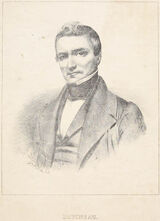
Louis-Joseph Papineau.
A financial crisis in London in late 1835 led to the Panic of 1836 in the C.N.A. Banks and businesses began failing in the Northern Confederation, and the crisis led to the rise of the Grand Consolidated Union. In Quebec, Louis Papineau organized a new resistance group called the Patriotes which blamed the financial crisis on the moneyed interests in New York and called for Quebec's independence from the C.N.A.
In 1839, Papineau led an uprising in Mont Michel that attracted 3,000 men, with an additional 800 coming from Nova Scotia. Papineau's army entered Quebec City on 21 September, but Governor Henry Scott had received word of Papineau's approach, and had called up the Quebec militia. Papineau's army came under heavy attack at the city gates, and was defeated within an hour. Papineau himself was killed in the attack; his last words were "Our cause is just and will prevail. But flesh and blood can do little against a wall of lead and iron." Papineau's son, Francois Papineau, fled to the United States of Mexico, and published a biography of his father in 1854.
When the leaders of the various confederation-level Conservative Parties met at the Brant Convention in September 1841, Quebec's Charles Lefort was one of the convention's leading figures. When the convention concluded in October, it issued a call for a reform of the Britannic Design to create a more unified C.N.A. The Liberals had held a similar convention in August, and had also come out in favor of a reform of the Design. The British Parliament responded by agreeing to a special meeting of the Grand Council in Burgoyne to amend the Design. At the Burgoyne Conference in the summer of 1842, the Second Britannic Design was drafted, transforming the Grand Council into a 150-member national legislature, and establishing the Governor-General as the chief executive of a national government.
Quebec was allotted twenty-four seats on the Grand Council. In the 1843 Grand Council elections, held on 14 February 1843, the National Conservatives won fifteen seats to the Unified Liberals' nine. However, the U.L.P. won majorities in every other confederation except Manitoba, and U.L.P. candidate Winfield Scott of Indiana was elevated to the office of governor-general.
Despite the defeat suffered by Papineau at Quebec City, the Patriotes continued to win support among Quebec's Francophone population under his successor, Charles de Frontenac. When the Rocky Mountain War broke out between the C.N.A. and the U.S.M. in September 1845, many Quebecois made no secret of their Mexican sympathies. De Frontenac continued to demand independence for Quebec, and between 1855 and his capture in 1864, the Patriotes killed some 3,000 Anglophone inhabitants. The Anglophones responded by creating a rival terrorist group called the Anti-Papists which burned Catholic churches and killed Francophones. The near civil war between the two groups prompted some half million residents to emigrate; the Anglophones to Massachusetts, Indiana, and Vandalia, and the Francophones to New Orleans, the U.S.M., and France. Quebec's population fell from 5.9 million in 1855 to 4.8 million in 1870.
In the 1853 Grand Council elections, the N.C.P. won all but two of Quebec's twenty-four seats, helping them to gain 91 seats in the Grand Council, completely reversing the U.L.P.'s majority ten years before. Manitoba Councilman William Johnson became the governor-general, and within two months he had opened peace negotiations with the Mexicans. An armistice between the two countries began on 1 August 1853, and on 7 August 1855 the Hague Treaty was signed, bringing the war to an end. The Conservatives continued to dominate Quebec's politics, winning fourteen out of twenty-two seats in the 1858 Grand Council elections, and maintaining their majority in the elections of 1863 and 1868. During this period of Conservative ascendancy, a group called the People's Party was formed in Fort Rasmusson. It proved to be short-lived, and had no connection to the party of the same name formed in Norfolk, Virginia in 1869.
Ezra Gallivan and the Quebec Plebiscite[]
Under the Conservative government of Herbert Clemens, the Grand Council passed the Reform Bill of 1870, reapportioning Grand Council seats among the confederations, which reduced Quebec's delegation from twenty-two seats to thirteen. The new council districts were drawn to favor the Conservatives, so that in the 1873 Grand Council elections, they won all thirteen of Quebec's seats.
A radical labor union called the United Workers of the World appeared in New York in the 1860s. The U.W.W. followed the teachings of a radical German political philosopher named Karl Marx who believed that the only way for workers to distribute the products of their labor fairly was to rise up, overthrow the industrialists, and run the factories themselves. The U.W.W. appealed strongly to militant Quebec Francophones, and by 1878 the union had joined with the Patriotes and practically vanished outside of Quebec.
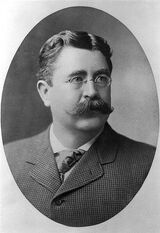
Ezra Gallivan.
A new political party called the People's Coalition had been founded in 1869, and by 1878 had grown to the point where it was able to contest all 150 seats in the Grand Council. The P.C. was able to take advantage of the reapportionment under the 1870 Reform Bill to win six seats in Quebec in the 1878 Grand Council elections, with the Conservatives winning another six seats, and the Liberals one. Ezra Gallivan of Indiana was elected Mayor of Michigan City under the Coalition banner in 1882, and his skillful work building up the P.C. allowed it to displace the Conservatives as the majority party in Quebec, winning seven of the confederation's Grand Council seats in the 1883 elections, with the Liberals winning four and the Conservatives two.
Gallivan was able to lead the People's Coalition to a plurality in the 1888 Grand Council elections, and was elevated to the governor-generalship on 19 February 1888. Within Quebec, the Patriotes were able to elect one of three independent candidates, with the P.C. winning five, the Conservatives three, and the Liberals two. In his inaugural address, Gallivan admitted that "Quebec has real and long-standing grievances against the national administration," and pledged that "every attempt will be made to secure the full loyalty of every citizen of that important state."
Gallivan then made a visit to Quebec City, defying assassination threats by the Patriotes. He walked among the crowds, and delivered a speech to the Francophone citizens, ending with the words "I have heard, and I have understood." His audience cheered, though more than one admitted that he didn't know why.
On 1 February 1889, Gallivan gave an address to the Grand Council in which he proposed a plebiscite for Quebec, in which the confederation's people could vote to either remain part of the C.N.A., become an associated state, or become independent. The speech was received in shocked silence by the majority of the council, but the Quebec delegation rose up to cheer Gallivan, and after a moment the rest of the Council gave a round of polite applause. The next day, most North American newspapers supported Gallivan's proposal, and it was ratified by the Grand Council on 9 February.
The Quebec Plebiscite was scheduled to take place on 6 July 1889, and the confederation's population immediately divided among three parties: the largest was the pro-independence Free Quebec Coalition, which included the Patriotes. The smallest was the pro-C.N.A. Loyalty Party, which included wealthy businessmen and monarchist exiles from France. In between was the pro-association Justice and Peace Party, which included middle-class farmers and Quebecois with ties to Nova Scotia.
Supporters of the Free Quebec Coalition destroyed opposition offices and threatened an uprising if the vote did not go for independence. However, the attempt at intimidation backfired. Support for the Free Quebec Coalition fell, and on 6 July a majority of Quebecois voted for associated status: the vote went 54% for associated status, 41% for independence, and 5% for the status quo. As an associated state of the C.N.A., Quebec had control of all internal affairs while remaining associated with the C.N.A. on issues of common interest. Quebec lost its thirteen members in the Grand Council, though like Nova Scotia it had the right to send three observers. Following its change in status, the former confederation became known again as the Province of Quebec, or the Associated Confederation of Quebec.
Associated Status[]
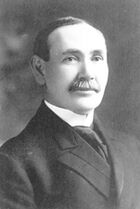
Christopher Hemingway.
Sobel makes few mentions of Quebec after the plebiscite, except to mention that Governor-General Christopher Hemingway toured the state in 1905, and was well-received, indicating that antagonisms between Quebec and the rest of the C.N.A. were dying away. When French President Henri Fanchon sent fraternal greetings to the government of Quebec in 1912, in an attempt to entice the province into a political alliance, he was rebuffed.
During the Diffusion Era of the 1920s, the sparsely settled areas of Quebec received hundreds of thousands of emigrants from elsewhere in the C.N.A. under the Galloway Plan. In 1930, under Governor-General Douglas Watson, a semi-autonomous branch of the National Financial Administration was established in Quebec City. The N.F.A. branch would be financed independently, and would serve the needs of the people of Quebec. However, like the rest of the N.F.A.'s branches, the one in Quebec City became overextended, and when the Panic of 1936 struck, it was declared bankrupt on 16 March.
Sources[]
Sobel's sources for the history of Quebec are Pierre Ribot's My Life and Works (London, 1829); Francois Papineau's My Father: His Cause was Just (Mexico City, 1854); Armond Fleur's We Leave as Friends: The 1889 Plebiscite (New York, 1945); Wayne Carton's Brothers in Oppression: The U.W.W. and the Patriotes (Mexico City, 1950); Thomas Taggert's Ribot of Quebec: Patriot or Demagogue? (New York, 1954); John Reynald's Background for Rebellion: Quebec, 1800-1838 (New York, 1956); Etienne Bayard's The Decline of Quebec (New York, 1965) and The Sputtering Fuse: The French Question in Quebec in the Nineteenth Century (Quebec City, 1967); and Davis Malone's The History of Quebec (Dorchester, 1967). In his preface, Sobel thanks James Duferre, the Minister of Home Affairs in the Province of Quebec, for reading the sections of For Want of a Nail ... dealing with "the province and former confederation."
This is the Featured Article for the week of 2 March 2014.
| Confederations of the C.N.A. |
|---|
| Central Confederation • Indiana • Manitoba • Northern Confederation • Northern Vandalia • Quebec • Southern Confederation • Southern Vandalia • Vandalia |
| Associated Confederations of the C.N.A. |
|---|
| Nova Scotia • Quebec |
